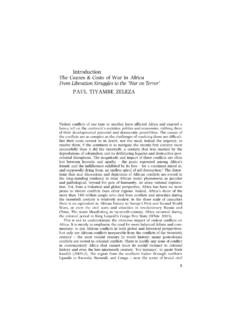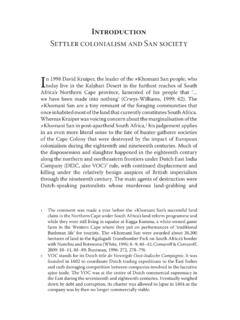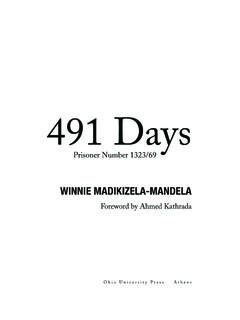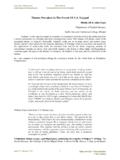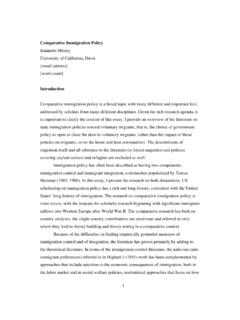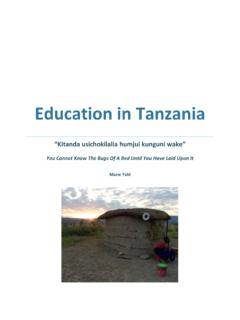Transcription of Dance of Life: The Novels of Zakes Mda in Post-Apartheid ...
1 InTroDucTionZakes MdaZakes Mda was born Zanemvula Kizito Gatyeni in 1948 in the Eastern Cape. He spent his childhood in Soweto, and then moved to Lesotho to join his father in exile. One of South Africa s foremost writers, he has produced plays, Novels , poems, and academic articles in addition to being a musician and graphic artist. Mda is now Professor of Creative Writing at Ohio University, but he continues to make frequent trips to his native South Africa to launch his Novels and to work in community initiatives such as the beekeeping project on the Pink Mountain described in his recent memoir, Sometimes there is a Void. This autobiographical work exhibits some of Mda s most striking characteristics: his sense of place, which enables him to create his characters, and his conviction that his writing cannot be separated from his commitment to building work in both theatre and fiction has been compared to that of leading African writers, including Chinua Achebe, Wole Soyinka, Ngugi Wa Thiong o, Andre Brink, Njabulo Ndebele, J.
2 M. Coetzee, Ivan Vladislavic, Antjie Krog and Etienne van s plays, which include Dark Voices Ring (1979) , The Hill (19 8 0) , We Sh all Sing for the Fatherland (19 8 0) , Collected Plays (1980 and 1990), And the Girls in their Sunday Dresses (19 9 3) , Dankie Auntie (19 97) , Let us Play (1998) and Fools, Bells and the Habit of Eating: Three Satires (2002) have been published by Ravan Press, Wits University Press, Matatu: Journal for African Culture and Society and Vivlia Press. His poetry is widely published, starting with a collection titled Dance of the Ghost, published in 1977 and culminating with the printing of Slaughtered Gods and Uninspired Graffiti in a 1996 issue of the literary magazine, s work has in recent years attracted worldwide critical attention.
3 This is attested by the number of international scholarly journals that have carried articles on his fiction, such as Kunapipi, Diacritics and Critical Quarterly. South African journals that have published articles on Mda include The English Academy Review, Current Writing and English in Africa. In 2009 David Bell and J. U. Jacobs brought out the first collection of critical essays on Zakes Mda. The 19 South African and international authors contributing to this collection, 1 See the Introduction to Zakes Mda: Ways of Writing (Pietermaritzburg: University of KwaZulu-Natal Press, 2009) by Bell, David and Jacobs, J. U., 132011/06/27 2:44 PMDance of Lifexivtitled Ways of Writing: Critical Articles on Zakes Mda, discuss Mda s plays and his Novels .
4 The editors have included lists of Mda s fiction, drama, poetry, scholarly works and published articles, and appended a critical bibliography of the most important articles on his work. Many of the essays in Ways of Writing are referenced in Dance of Life, which is the first single-author monograph on the fiction of Zakes Mda to be published to is with Mda s Novels that this book is chief ly concerned. Beginning in 1995, and ongoing in 2011, they mirror the establishment of Post-Apartheid South Africa, which began with the release of Nelson Mandela in 1990 and the election of the country s first ANC government in 1994. What makes a monograph on Zakes Mda particularly timely is the author s engagement in the cultural, historical and social complexities of the new South Africa.
5 Mda has had many years of experience in writing for theatre, and of using performance techniques to educate people for democracy. But his self-invention as a novelist experimenting with narrative techniques begins with South Africa s transition to democracy. He investigates the roles of history, community and memory in reforging a new national identity. His Novels thus contribute to the many debates around nation-building, memory and reconciliation since 1994, and the way these inf luence the construction of narrative. In Memory, metaphor and the triumph of narrative , Njabulo Ndebele records the movement of our society from repression to expression (Ndebele: 1998, 20) embodied in the hearings and writings of the Truth and Reconciliation Commission: These stories may very well be some of the first steps in the rewriting of South African history on the basis of validated mass experience (Ibid, 20).
6 No less than the stories produced by the Truth and Reconciliation Commission, Mda s narratives dramatise the co-existence of competing versions of history. Ways of Dying dramatises creative autonomy versus disempowerment. The Heart of Redness juxtaposes colonial bigotry against Xhosa customs and traditions. In The Madonna of Excelsior official apartheid history contradicts non-racist, non-gendered artistic expression. Cion offers storytelling and quilt-making as alternatives to capitalist role of narrative in coming to terms with the past is emphasised by David Bell: [I]n the reassessment of the past, the voicing of silences, the need is not to record, to witness and to represent, but to storify (Bell: 2003, 63).
7 Bell talks 2 In a research project undertaken in 2009, the following figures for students working on Mda texts in South African universities were compiled: University of Cape Town, 500; University of the Witwatersrand, 450; University of Fort Hare, 110; University of Pretoria, 580; Walter Sisulu University, 400. Figures were not available for readers of Mda texts in postcolonial courses around the world, but are assumed to be much higher than those for South 142011/06/27 2:44 PMintroDuctionxvabout Paolo Freire s distinction between dialogic and anti-dialogic societies. It is Mda s rejection of the anti-dialogic society, whatever its political or racial constitution, that accounts for his even-handed fictional treatment of black, white and coloured protagonists from diverse backgrounds.
8 This depiction is both compassionate and humorous. Essential to Mda s capacity to speak to the needs of the new South Africa is the tool of satire he frequently uses in his fiction. Ralph Goodman observes: [Mda] sets up a dialectic which does not allow for absolute categories of oppression or collusion (Goodman: 2004, 63). This refusal to be ideologically proscriptive is born of Mda s empathy, his identification with both the perpetrators and the victims of apartheid. This is why his fiction is so important in South Africa Dance of Life ?This book is about Zakes Mda s fiction and explores the performative dimension of his Novels in particular. His protagonists are involved in writing, speaking, acting, singing, playing instruments, creating sculptures and dancing.
9 Mda s fiction also involves both author and reader in performative responses. This book s title, Dance of Life, dramatises this performative dimension: Mda creates narrative designs that his characters perform and his readers construe. It also links with the epigraphs that preface this book. The Dance metaphor alludes to J. M. Coetzee s notion, explored in Elizabeth Costello, of the interconnection between humans and non-humans as celebrated in the metaphor of the Dance . The hymn of the second epigraph links the moon, stars and sun to the inhabitants of earth in a cosmic Dance , while in Yeats Among School Children the chestnut tree s roots, trunk and f lowers together represent a somatic unity in which dancer and Dance become Dance metaphor is useful to the understanding of Zakes Mda s fiction, because it involves author, characters and readers in a kind of performance.
10 This is ref lected in the book s representation of visual images. The front cover shows Lesley Charnock s striking painting of dancers, while the painting of intertwined figures on the back cover and on Plate XVI is by Mda himself. The Frans Claerhout paintings on which Mda builds The Madonna of Excelsior are reproduced so that readers can see how Mda s story-world in this novel dialogues with that of Claerhout. Mda says that all his artwork explores the Dance motif, either realistically or in abstract Crucial to the performative dimension into which Mda inducts his readers is the visual 3 Grateful thanks to Teresa and Albio Gonzales in Barcelona, who own the painting by Zakes Mda displayed on the back cover and on Plate XVI, and who gave me permission to reproduce 152011/06/27 2:44 PMDance of Lifexvirepertoire orchestrated in all his Novels .
